Why Has Journalism Imploded Irreversibly
Journalism is imploding across the world. Journalists, who brought this upon themselves, are still blaming the society. Is that the reason for their industry's destruction?

Journalists were always known as the Fourth pillar of democracy.
The first estate is the executive branch of a government. The second estate - the legislative branch of a government. The third estate is the judiciary.
Then came the 5th estate. A socio-cultural term that refers to groups of outlier viewpoints in society today. Bloggers, and commentators on the new platforms.
Things changed. Soon, sensationalism, favoritism and eyeballs became the sine qua non of journalism.
The more partisan and shrill the viewpoint and presentation, the higher its value in the new world. What was happening in the 5th estate started dictating things in the 4th.
Partisanship - extreme and irreconcilable (for reconciliation would mean a fall in ratings!) - increased and became a permanent feature.
This meant that journalism and the political operatives behind them could go to any level and point. Even to the point of ruining the society and breaking it apart.
Care for lay people was turned off. They didn't matter anymore. Pretense to that did, however.
Pretense has a way of being caught. Sooner or later. And when it became blatant and openly in your face, people jettisoned the media.
The world of journalism is now feeling that rejection.
Mayhem in the Newsroom
On January 24th, the newsroom of one of the largest daily in the US faced a chaotic time. Over 20% of its newsroom was laid off. The employees faced this in the morning they came in. LA Times had been sold from Tribune Publishing to a biotech billionaire Patrick Soon-Shiong in 2018.
Oliver Darcy writes on CNN about the chaos and the situation within the LA Times and indeed across the news publishing industry. The last paragraph is quite striking in its tone and attitude. In that paragraph and the overall coverage by his media house lies the fundamental reason for not just the sliding trust in journalism but its ultimate demise.

The rot is clearly visible, isn't it?
Journalists do not want to give us news. They want to run the society and the nations to craft the news they want!
That has taken them away from what started off as a vocation requiring high trust and in turn offering them an immunity not extended to any in the society.
Therefore the "chaos."
And it's not just the LA Times that is going through such bloodletting. It is everywhere!
Patrick Soon-Shiong, the billionaire publisher of the Los Angeles Times, laid off 20 percent of his newsroom. Over at Time magazine, its billionaire owners, Marc and Lynne Benioff, did the same for 15 percent of their unionized editorial employees. This latest conflagration had ignited at Sports Illustrated the previous week as catastrophic layoffs were dispensed via email to most staffers. Business Insider (whose parent company Axel Springer also owns POLITICO) jettisoned 8 percent of its staff while workers at Condé Nast, Forbes, the New York Daily News and elsewhere walked out to protest forthcoming cuts at their shops. The news business has always been cyclical, dipping during economic downturns and then improving on the upswing. But not so anymore, as our economy has been surprisingly strong of late. Nearly everywhere you look — the Washington Post, NPR, Vice, Vox, NBC News, Texas Tribune, WNYC, Barstool Sports, just to name a few — companies have axed huge swathes of staff. Newsroom employment is down more than 26 percent since 2008. Buzzfeed News is dead. The magazine business has atrophied, too, as newsstand revenues have fallen from $6.8 billion in 2006 to $1 billion in 2022. Looking on as the media business bleeds out, journalism professor Jeff Jarvis, a man who once evangelized for the industry’s electronic future, folded his hands in his lap like a mortician and asked in his blog if it was time to give up on old news. Citing the dark layoff news, Jarvis tidied the corpse-in-the-making. Trust in journalism has melted, he noted, and private equity shops like Alden Global Capital are cannibalizing their newspapers. (Source: "The News Business Really Is Cratering" / Politico)
Today, let us understand what is going on in the news industry and where is it headed.
Origins of Journalism
The origins of journalism can be traced back to ancient times when news was disseminated through word of mouth, handwritten newsletters, and early forms of printed publications. However, the concept of a modern newspaper as we understand it today began to take shape in the 17th century.
The first newspaper, Acta Diurna, is believed to have been published in ancient Rome around 59 BC. Acta Diurna, which translates to "Daily Acts" or "Daily Public Records" in Latin, were daily notices posted in public places in ancient Rome. They were a type of daily gazette, and some say they were the prototype for the modern newspaper. (Source: Acta Diurna: The Telegraph of Ancient Rome, Bringing You All the Latest Gladiator Combat News / Ancient Origins)
In 1605, the first printed newspaper, Relation, was published in Strasbourg, Germany. This was a newsbook titled Relation aller Fürnemmen und gedenckwürdigen Historien (Account of All Distinguished and Commemorable News). It was published by Johann Carolus in Strasbourg and is alleged to be the first European newspaper.
Johann Carolus, who had previously earned his living by producing hand-written news sheets for wealthy subscribers, acquired a printing press and began printing the Relation.
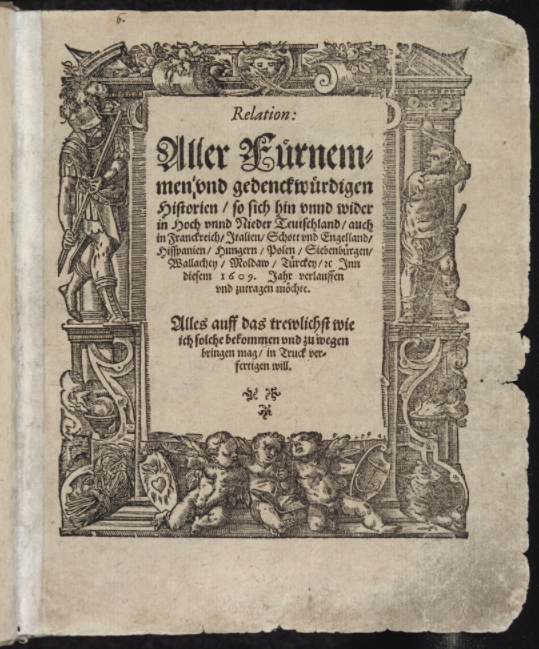
The earliest journalism works were closely aligned with the religious need to evangelize as well.
The earliest magazine appears to have been the German Erbauliche Monaths-Unterredungen (1663–68; “Edifying Monthly Discussions”), started by Johann Rist, a theologian and poet of Hamburg. Soon after there appeared a group of learned periodicals: the Journal des Sçavans (later Journal des Savants; 1665), started in France by the author Denis de Sallo; the Philosophical Transactions (1665) of the Royal Society in England; and the Giornale de’ letterati (1668), published in Italy and issued by the scholar and ecclesiastic Francesco Nazzari. A similar journal was started in Germany a little later, the Acta eruditorum Lipsiensium (Leipzig; 1682); and mention may also be made of the exile-French Nouvelles de la République des Lettres (1684), published by the philosopher Pierre Bayle mainly in Holland to escape censorship. These sprang from the revival of learning, the need to review its fruits, and the wish to diffuse its spirit as widely as possible. (Source: Magazine publishing / Brittanica)
From those earlier attempts to share information, the news business grew. Whether it was the gossip of celebrities or the machinations of politics, people's interest was worth a price that they were willing to pay.
India's Tryst with Journalism
In the Indian context, Sage Narada has been regarded as the original 'journalist' given his character and work in the scriptures. Well, he was far more than just a gossiper as he is made out to be.
In any case, given India's tradition of writing and expression, all the scriptures and Dharmic practices stayed alive via the oral traditions. Mahabharat and Ramayana were disseminated across the country and indeed the world via plays and ballads and more importantly through sermons. In our previous newsletter, we shared how Shri Ram was known to the residents of Xinjiang as he was known to folks in Japan and Brunei.
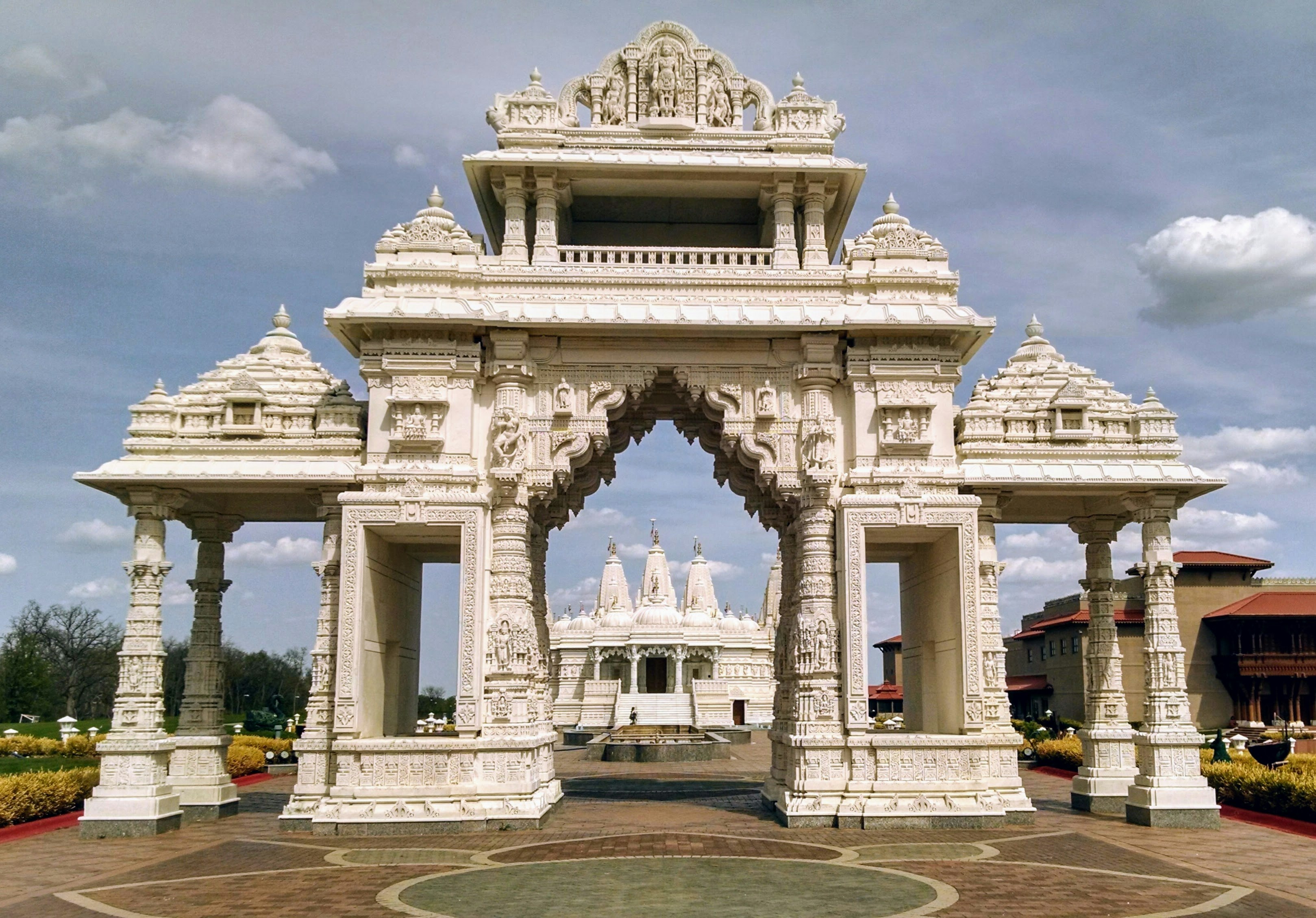
Fast forward to 1779, when the first newspaper in India, Hicky's Bengal Gazette, was launched by James Augustus Hicky. This marked the beginning of journalism in the Indian subcontinent, paving the way for the development of a vibrant and diverse media landscape.
Other publications followed, such as The Bengal Journal, Calcutta Chronicle, Madras Courier, and Bombay Herald. Most of them were hit by censorship from the East India Company.

India's freedom struggle against the British was built upon thinking men and women. Many of the Indian leaders were associated with journalism.
- In 1913, Sardar Kartar Singh Sarabha started a Punjabi newspaper - The Ghadar. It was financed by the Stockton Gurudwara. It was the voice of the Ghadar Party in the US.
- Bhagat Singh started as an apprentice in well-known media organizations of his time, like Pratap and Vir Arjun. He worked in over a dozen newspapers and magazines like Kirti, Pratap, Maharathi, Vir Arjun, Matwala, Prabha, Akali, Chand, and Bande Mataram in different roles. (Source)
- Bal Gangadhar Tilak owned and edited two weekly newspapers, Kesari (“The Lion”) which was published in Marathi, and The Mahratta, which was published in English.
- Gandhi served as an editor of the Indian Opinion from 1903 to 1915 for both the Hindi and Gujarati versions. He also edited Harijan from 1919 to 1931. He also edited Young India and Navajivan.
Newspapers provided the Indian leaders with the platform to share their thoughts and wake up the masses while creating an intellectual churning that was needed.
But the press was curbed and curtailed by the British. For example, acts like the Vernacular Press Act were brought in to silence the indigenous press from criticizing the British.
Vernacular Press Act, in British India, law enacted in 1878 to curtail the freedom of the Indian-language (i.e., non-English) press. Proposed by Lord Lytton, then viceroy of India (governed 1876–80), the act was intended to prevent the vernacular press from expressing criticism of British policies—notably, the opposition that had grown with the outset of the Second Anglo-Afghan War (1878–80). The act excluded English-language publications. It elicited strong and sustained protests from a wide spectrum of the Indian populace. (Source: Britannica Encyclopedia)
The Indian press, nevertheless, survived these attacks and other curbs. Today, the tapestry of Indian journalism is very rich.
The dominance of Hindi publications in India is well chronicled. The country has almost 1,000 Hindi dailies claiming a circulation of nearly 80 million copies. That compares with about 250 English dailies claiming a circulation of about 40 million copies. The most number of newspapers in India are published in Hindi, followed by English, Gujarati, Urdu, Bengali and Marathi. (Source: Hindi dailies with local news rule the roost / Live Mint)
In India, Radio broadcasting began in 1927.
Over the years, the evolution of journalism has been characterized by technological advancements, changes in editorial practices, and shifts in the socio-political landscape. From the early days of print media to the advent of television and the digital revolution, journalism has continually adapted to meet the changing needs of society. Today, journalism encompasses a wide array of formats, including traditional newspapers, broadcast media, online news portals, and social media platforms, reflecting the dynamic nature of the field.
Post-Independence Indian Journalism
India's history of journalism in the post-independence era is rather grey. While some of the work that was done in some of the most trying times was truly outstanding, many of India's journalists in most of the decades have been puppets of their paymasters.
The most trying time for Indian journalism was during he emergency. That separated journalists from professional hitmen.
BJP leader and India's Home Minister during the UPA rule, Mr. LK Advani once famously said this about the pusillanimity of the press at that time. A charge he often repeated. (Source: WION)
Only two journalists - Ramnath Goenka (Indian Express) and CR Irani (The Statesman) - remained standing erect. The rest folded.
I was a university student. When I heard the news, I was on holiday, trampling the streets of New York, looking for an inexpensive hotel to check into. American dailies carried news of the Emergency but were sketchy on detail. Soon after returning to India, I joined The Times of India as a trainee reporter. The political atmosphere was grim. Only the Indian Express and The Statesman stood up to the harsh censorship laws Indira Gandhi’s government had imposed. Ramnath Goenka, the doughty proprietor of the Express, and CR Irani of the Statesman risked their personal freedom and their papers’ future by defying the censors who sat physically in several newspaper offices. My editors at the Times, Sham Lal and Girilal Jain, were fine journalists. But during the Emergency they – to put it kindly – followed the government’s instructions. (Source: "LK Advani is right. When asked to bend, the media crawled during Emergency" / DailyO)
The graveyard of Indian journalism during the emergency contains many famous names. Legendary even. These people - like Khushwant Singh - supported the emergency

Those were the journalists usurped by the powers of those times.
In November 1978 the then-Congress MP Mr. Pranab Mukherjee had read out names of Indian journalists who were on the CIA list. Later, in December 1978, another list was exposed.
The names were the whos-who of Indian journalism. Apparently, they were all on the CIA's payroll.
The 25 names mentioned include some of the most respected journalists in the country, including Girilal Jain, 56, editor of the Times of India; Nihal Singh, 49, editor of the Statesman; N.J. Nanporia, 55, former Times of India and Statesman editor; Ajit Bhattacharjea, 54, editor of Indian Express; Chanchal Sarkar, 52, director of the Press Institute of India and Prem Bhatia, 67, editor of the Tribune. The list is supposedly compiled by Inter-press, a Geneva-based group of seven journalists "who think their duty is to put an end to perverted abuse by the CIA of press and information freedom". (Source: "Pranab Mukherjee says top Indian journalists on payroll of CIA, causes a furore" / India Today)
CIA's interference in the Indian journalism sphere specifically during the initial days is a well-documented fact. (Source: "How The CIA Sponsored Indian Magazines That Engaged The Country's Best Writers" / The Wire)
CIA did all this because it believed the KGB itself was financing and backing the Indian newspapers, magazines, and even books in a big way.

The Mitrokhin Archives II confirmed this fact in some way as well.

As KGB's Kalugin said - The entire country was on sale!
It makes sense when you see how an Indian Cabinet minister demanded $50,000 for giving the KGB all the information it needed. Yuri Andropov rejected the offer because he had enough people on his payroll!
The agency had so many agents and sources that then KGB chief Yuri Andropov turned down an offer by an Indian cabinet minister for a payment of $50,000 in exchange for information. Suitcases of cash were sent to then prime minister Indira Gandhi for her party's war chest, not to mention vast sums of money funnelled to the CPI. (Source: "Book on KGB unveils Russian agency's ops in India during Cold War, political storm ensues" / Indian Today)
Such was the state of the politicians and the journalists.
While politicians in Modi's cabinet would have stopped offering the country on a platter, the journalists have no qualms. They are continuing in the glorious tradition set by their seniors.
Only now it is China who is buying them.
China has been accused of running a secret propaganda operation in India, after journalists and researchers in the country were approached by people claiming to be from Singapore-based institutions with offers to cooperate on projects or to write articles on security and foreign policy. The individuals, who were mainly contacted via email, direct messages on LinkedIn, Facebook, or WhatsApp, focused on topics such as India-China relations, India-Japan ties, or the Indo-Pacific region. The offers of payment for articles ranged up to $400 (nearly ₹33,000).(Source: Is China running a secret propaganda operation with journalists in India? / Live Mint)
The portal NewsClick was funded by the Chinese operatives.
The report alleged that NewsClick received millions in funding from American billionaire Neville Roy Singham, a close associate of the Chinese government. The report also highlighted some content published by NewsClick, aimed at pushing the narrative generally peddled by Chinese media and government. For example, the portal published a series of articles highlighting ‘China's steps to contain the Covid-19 pandemic.’ It also published a video titled “China’s history continues to inspire the working classes”. (Source: NewsClick’s alleged links to China; who received the money and when? / WION)
The newsrooms of Indian media houses have been snake pits, where the nation was sold and bought.
Profits over Human Lives - Barkha Dutt Case Study
And then there is the story of Barkha Dutt. She started out her career with NDTV as a TV reporter by compromising the Indian Army in a war against Pakistan.
While covering the operation, Barkha Dutt gave away the military location by concluding her live commentary by saying "Barkha Dutt reporting from 56 Brigade HQ" at the end. She didn't even blink or hesitate for a second before giving such a crucial bit of information on national television that too, live. (Source: When "Journalist" Barkha Dutt ended up helping Pakistan in the Kargil War" / News Bharati)
Here is an example of her reportage - all done live - to Pakistan's advantage and jeopardizing the lives of Indian soldiers.
Dutt is a repeat offender.
She jeopardized lives of hundreds during the terrible siege in Mumbai on November 26th, 2008, when she revealed the locations of many within the hotel while live-feed was going to the Pakistani handlers of the terrorists who were directing them in real time via satellite phones.
The Indian Supreme Court called this out in its judgment as well.

Here is an example of her reportage that put the lives of innocents in danger!
Needless to say, she endeared herself to the perpetrators of terror crimes in Pakistan. Criminals who could always count on her help.
Here is Hafiz Saeed, the mastermind of 26/11 praising her work.
However, back in India, when her shameful reportage was called out by a blogger, she slapped a court case with a hefty sum so the guy was forced to bring his post down. Chyetandya Kunte had to delete his post and also inform others who had linked to his post (including Drishtikone at that time).
“Shoddy Journalism” was the title of a blog post written by a blogger named Chyetanya Kunte during the Mumbai terror attacks of 2008. In his post, Kunte criticised the media, especially controversial journalist Barkha Dutt, who was then with NDTV. Subsequently, Kunte received a legal notice, and he proceeded to delete the blog post and issue an apology to Barkha Dutt and NDTV. The apology and the original blog post content are available at this page released by the WikiLeaks. (Source: Book reveals that Army was spooked by Barkha Dutt’s reporting in Kargil / Opindia)
Dutt was also involved in a political office-fixing scandal which came to light when her conversation with Niira Radia, a political lobbyist in India.
Barkha Dutt assures Radia of getting Ghulam Nabi Azad, Congress general secretary in charge of Tamil Nadu to talk to Karunanidhi to get the DMK portfolios in the Union cabinet fixed according to the wishes of TN chief minister's daughter Kanimozhi. (Source: Transcript: Radia and Barkha Dutt / India Today)
Indian journalists have been compromising not just the future of India and jeopardizing the national security at critical junctures, they have had little care for the common man on the street.
They did not even allow the privacy to the dead during COVID. In a bid to make money, the Indian journalists sold pictures from the cremation grounds - a sacred ceremony for most Hindus.
The British-American media company Getty Images now hosts multiple images depicting multiple Indian funeral pyres lit ablaze on their website. From here, any potential media group around the world can buy these images, in three different sizes, with the largest size priced at about Rs. 23,000. In fact, most of the large versions of the images are priced at Rs. 23,000. (Source: Tragedy porn amid COVID-19 crisis: Photographs of funeral pyres from India selling for Rs. 23,000 each on stock image sites / Opindia)
No other society was humiliated during COVID-19 in this manner despite numerous deaths everywhere.
So, if the Indian journalists of today are divorced from the Indian public, there is a reason.
There is a significant and persistent trust deficit between the people and the media in India; As per the Digital News Report, 2021, published by the Reuters Institute, only 38% Indians trust most news, compared to 65% in Finland, 50% in Thailand, 54% in Brazil, and 61% in Kenya. Low trust is usually ascribed to biases in media reporting. This conclusion comes naturally for a country where close to 70% of media revenue comes from advertisements and 30% from reader subscriptions. We, however, show that a part of this low trust is also explained by the disparity in the media coverage of urban and rural conflicts. (Source: Why most Indians don’t trust news? A study of land conflicts answers / The Print)
But the journalists keep wondering why there is this mistrust at all? Seldom looking at their own actions of betrayal with the most sacred of vocations in a democracy!
Global Market of News Media
The state of the global market of media is now falling rapidly. The global market is currently at USD 123 billion. And falling!
The global print newspapers & magazines market size was valued at USD 123.93 billion in 2021 and is expected to decline at a compound annual growth rate (CAGR) of -2.3% from 2022 to 2028. Newspapers and magazines have been gradually losing customers for years. (Source: "Print Newspapers & Magazines Market Report, 2028" / Grand View Research)
In the US, which is the largest news market, the top ranking newspapers are the iconic names that we have all heard of.

However, many do not know that behind these publications are the conglomerates that own them. The landscape of the United States' print media is dominated by 16 major newspaper conglomerates.
In 2023, the sequence of the list may have changed a bit, but the players remained the same largely.

Let us look at some of the largest players in the market.
Gannett As of 2023, Gannett is the largest newspaper publisher in the United States, with 230 daily newspapers. Gannett also owns almost 1,000 weekly newspapers and operates in 44 states, one US territory, and six countries.
It is the powerhouse behind USA TODAY and a vast network of local media entities spanning 43 states in the U.S., complemented by more than 150 news brands in the UK. (Source) Over the last few years, it has reduced its operations.
At the end of 2019, Gannett merged with GateHouse Media and between them the two companies had roughly 25,000 employees. Less than four years later, the current workforce is around 11,000. Since that 2019 merger, Gannett has reduced the number of papers in its circulation at a steady rate. According to reporting from Nieman Lab, Gannett owned 261 daily and 302 weekly newspapers in 2019. By the end of 2022, those numbers had dropped to 217 dailies and 175 weekly newspapers, a reduction of 171 in total. (Source: How America's largest newspaper company is leaving behind news deserts / MPRNews)
Lee Enterprises has nearly 350 weekly and specialty publications serving 73 markets in 26 states. (Source)
CNHI, or Community Newspaper Holdings: is the parent publisher of more than 130 local community newspapers in the United States. Some of the newspapers published by CNHI include:
- Americus Times-Recorder: A daily newspaper published in Americus, Georgia
- Cordele Dispatch: A weekly newspaper published in Cordele, Georgia
- Allied News: Published in Grove City, PA
- Andover Townsman: Published in Andover, MA
- Athens Daily Review: Published in Athens, TX
Alden Global Capital: As of November 2023, Alden owned more than 200 newspapers, including the Chicago Tribune, The Baltimore Sun, and the New York Daily News. Alden is the second-largest newspaper owner in the United States, after Gannett Co.
Ogden Newspapers: As of July 2023, Ogden Newspapers publishes more than 50 daily newspapers, magazines, and weekly newspapers in 18 states. Some of their publications include:
- The Messenger: Fort Dodge, Iowa
- The News-Sentinel: Fort Wayne, Indiana
- The Wheeling News-Register: West Virginia
- Sierra Sun: Truckee, California
- Tahoe Daily Tribune: South Lake Tahoe, California
- Cape Coral Daily Breeze: Florida
Quite clearly, the trend is towards acquiring as many local news outlets as possible.
Global News Media
Globally, however, a Japanese newspaper has the highest circulation. Here are the top ones. Asia seems to rule the world of journalism in terms of circulation.
- Yomiuri Shimbun (Japan): Known as the largest newspaper in the world by circulation, Yomiuri Shimbun has a daily circulation that reaches millions, offering national and international news.
- The Asahi Shimbun (Japan): Another leading Japanese daily, The Asahi Shimbun, is highly regarded for its journalism and also boasts a circulation in the millions.
- USA Today (United States): One of the top newspapers in the U.S., known for its comprehensive coverage of national news and its widespread distribution across the country.
- Dainik Bhaskar (India): A major Hindi-language newspaper in India, Dainik Bhaskar has a vast readership, especially in the northern parts of the country.
- The Times of India (India): English-language daily that is widely read throughout India and is known for its diverse coverage spanning local, national, and international news.
- Reference News (China): Published by Xinhua News Agency, it is known for providing news from foreign publications translated into Chinese, with a significant circulation.
- People's Daily (China): The official newspaper of the Central Committee of the Communist Party of China, with a wide distribution both nationally and internationally.
Everything is not great in journalism as we saw at the start of this article. The market is tanking.
Deconstruction of the News Industry
As per a report in Axios, a major shift is happening within the US market.
The forthcoming shift in U.S. newspaper ad revenue, as per the PwC report, marks a historic event, with digital ad revenue projected to surpass print ad revenue in 2026. This transition reflects a significant milestone in the global media market.
The slower migration of ad revenues from print to digital platforms within the newspaper sector is attributed to the local footprint of newspapers, which has impeded their ability to swiftly adapt to digital advertising trends compared to the broader publishing landscape.
in the report, CJ Bangah, a media industry principal at PwC, says that the variance in digital transformation willingness is not the primary factor but rather a marketplace distinction is influencing the industry's shift.
The report indicates a projected $2.4 billion loss in ad investment for U.S. newspaper publishers between 2021 and 2026, largely due to declines in print advertising. While digital ad revenue is expected to experience marginal growth, it is unlikely to offset the overall decline in ad revenues for the industry.

Over the years, advertising revenues and circulation have seen a decline after a brief high at the beginning of the century.

This is evident in the circulation numbers as well.

As things change, there is a tussle between the digital and the newsprint journalism. As things stand, the digital media is rising. But for the established players, the total circulation is on the way down.
For the most part, daily newspaper circulation nationwide – counting digital subscriptions and print circulation – continues to decline, falling to just under 21 million in 2022, according to projections using data from the Alliance for Audited Media (AAM). Weekday circulation is down 8% from the previous year and 32% from five years prior, when it was over 30 million. Out of 136 papers included in this analysis, 120 experienced declines in weekday circulation in 2022 (Source: Audiences are declining for traditional news media in the U.S. – with some exceptions / Pew Research Center)
Currently, as is obvious, the trajectory is downward. We will see a tremendous fall in the fortunes of global journalism media in the coming years.

Since 2002, the revenues have fallen to almost half by 2020.
Periodical publishers, who print and distribute magazines, scholarly and scientific journals and religious publications, saw their revenues decline by nearly as much, from $40.2 billion in 2002 to $23.9 billion in 2020. Publishers took the biggest hits from a rapid decline in the value of advertising they sold. Since 2013, the revenues generated from subscriptions and sales of newspapers increased by about 10 percent, from just under $8 billion to about $8.8 billion. But advertising sales plummeted, from $16 billion in 2013 to just over $10 billion in 2020, accounting for virtually all of the lost revenue over those seven years. The culprits are clear: Over the same time period, revenues generated by internet publishing and broadcasting firms and web search portals — companies like Facebook, Google and Amazon — saw advertising revenues skyrocket. More recent data from the Service Annual Survey shows advertising across those platforms more than triple, from $49.3 billion in 2013 to $160 billion in 2020. (Source: New data shows newspaper revenues down sharply / The Hill)
Here are the charts that one should check out to see the state of journalism today.
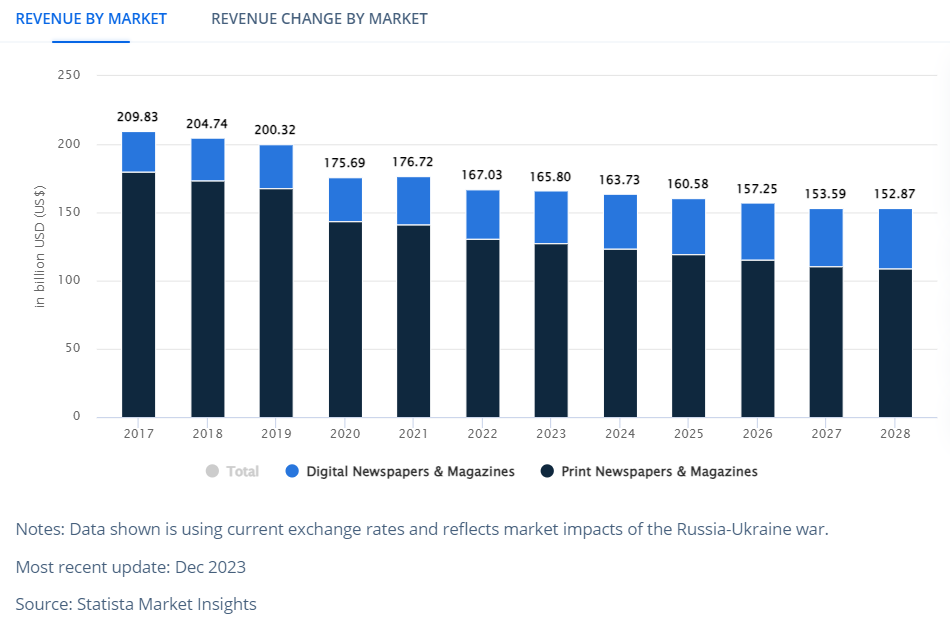
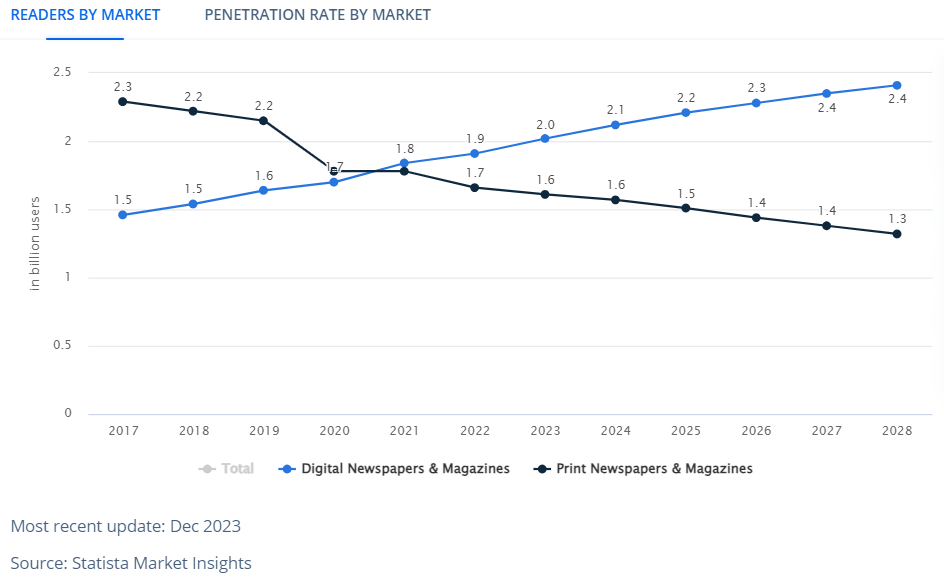
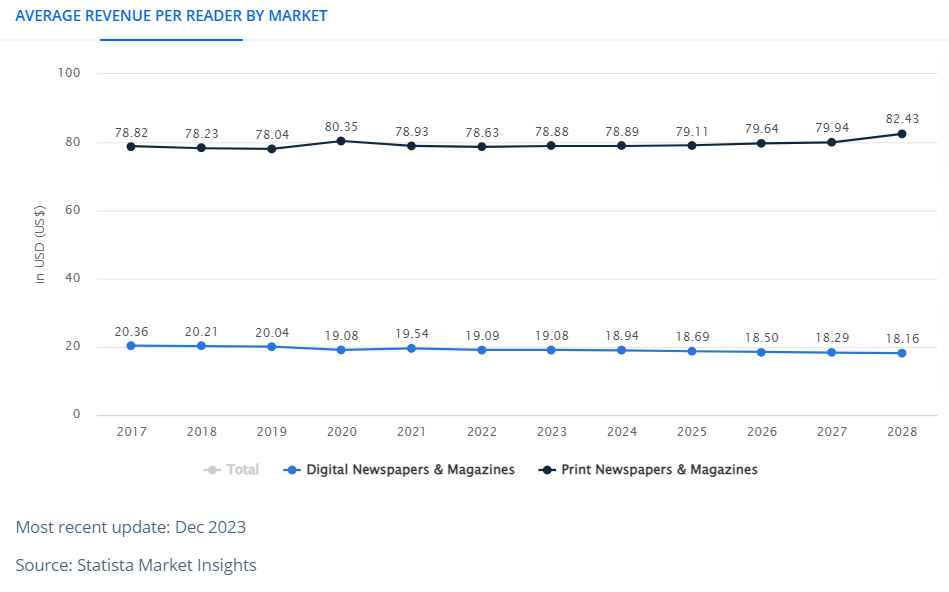
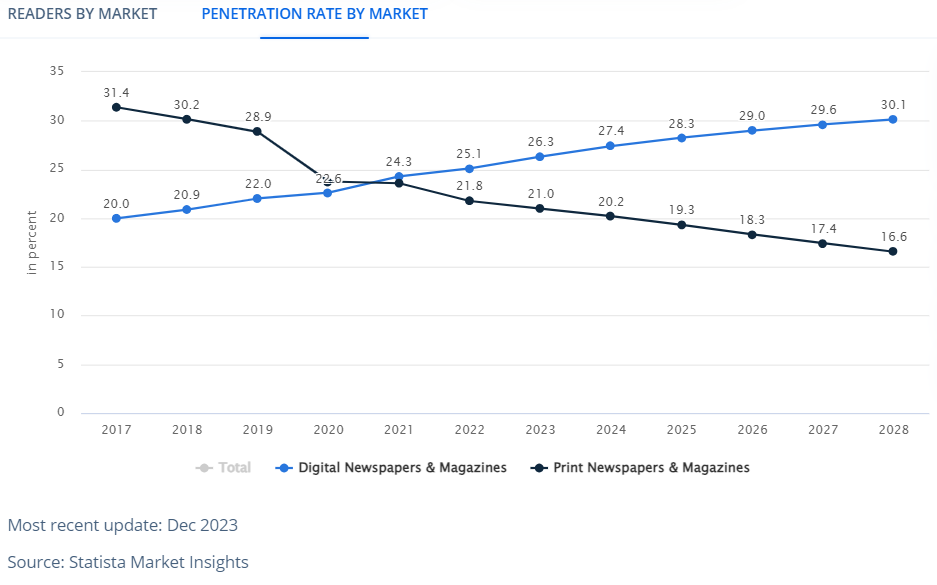
Source: Newspapers & Magazines - Worldwide / Statista
What is causing all this?
Disconnect and Arrogance
Over the years, the swagger of journalism has become unbearable for the normal population to even bear. They are prosecutors, pastors, judges and executioners all rolled into one. In many areas, they have a very thin knowledge layer but they are not afraid to give normative prognoses to society at large.
A Cincinnati resident Gil Spencer asks a relevant question - if journalists have the right to expression, even extreme expression, to criticize any person or institution, then does society have access to the same rights?
Or in other words - Are journalists beyond the criticism of society? More than the equals?

The reason for the decline of journalism that - obviously - most journalists and opinion-makers have put forth is: partisanship!
That reason is a lazy argument that is predicated on absolving the journalists of their own wrong-doings and once more (even in their demise) blaming society for it.
But that is precisely the reason why the journalists are where they are. They have abandoned society and aligned themselves with the powers at the helm and the money that comes in to perpetuate those powerful in their favor.
Batya Ungar-Sargaon, deputy opinion editor of Newsweek magazine, argues, we believe correctly, that the culprit is not partisanship in the society and even journalistic tendencies, but that it has become a class struggle. And the journalists have abandoned the middle classes. This is in contrast to a time when journalism was quintessentially a middle-class career and vocation.
From a time when the Democratic or Liberal leadership in the US or the world was about espousing the issues encountered by the poor and the working class, society has now come to a point, where the tonality and the structure of the issue statements are completely in the realm of upper class rich educated and mostly guilty white people.
What Batya shares is very pertinent. The Woke takeover of the news and opinion platforms.
It is important to understand the beginning and the underpinnings of the Woke takeover.
The Woke Takeover and the Backlash
This rot started when Wokes took over the liberal and institutional framework. An attack that was laden with the ammunition of guilt and assigning of past crimes on today's generation.

The DEI - Diversity, Equity, and Inclusion - agenda that was unleashed in 2020, has created a monster that is very tough to contain now.
The impact of the DEI practices has been damning as it proceeds with arm twisting and impact on the salaries of corporate executives.
In the video below, IBM's CEO, Arvind Krishna, makes statements emphasizing the importance of diversity in the hiring process, suggesting that executives' compensation could be influenced by their efforts to hire more Hispanic candidates.
And a failure to do that would result in a reduction of bonuses the IBM CEO said.
Supposedly to address perceived imbalances in the workforce, Krishna said that the companies could take terminal actions as well if the executives did not meet their DEI goals - which included termination, demotion, or reduction of bonuses for executives.
What are these "goals"?
One set consists of diversity hiring goals, particularly concerning increasing the number of Black and Hispanic employees.
As for Asians - a super minority in the US, he pointed out that Asians don't need the support. With that, he dismissed them en masse.
Asians are currently not considered an underrepresented group in the tech industry in the United States. Only Blacks and Hispanics.
Another guy talks on the video - Paul Cormier, the chairman of Red Hat (an IBM subsidiary). He says that his company has dismissed individuals who were not compliant with the company's initiatives to promote racial diversity in hiring and promotion practices.
So, all those threats around the DEI implementation and its impact on people's jobs - are real!
What is true of the corporate world, is also true of journalism.
In the quest for that elusive and quite honestly, hypocritical "equity" in public life, the powers-that-be have gotten on a road to destroy society.
And people know that. They are aware of the agendas and their impact on their daily lives.
It is this disconnect that has eroded trust in media and journalism. Not partisanship.
Just as Barkha Dutt, the poster girl of everything that is wrong about Indian journalism, has built her fortune on the corpses of thousands of innocents - soldiers and common people - without regard or remorse, the global journalistic fraternity is complicit in abandoning the man and woman on the street.
When journalism is no longer about society and its actions, but more about the ideas of control that the elites harbor, then we have backlash.
When the public says, we no longer trust your trash any longer.
Journalists, who brought this upon themselves, are still blaming society. Is that the reason for their industry's destruction?
Going Forward
It is often difficult to say what shape journalism will take going forward, but the journalism that we grew up with is gone.
In the coming years, a new media type and structures will come in. Artificial Intelligence will take over most tasks.
Even writing.
And marketing, creativity, and editing of course.
But what about the local reportage?
Without reporting from the ground, there is no journalism. Opinions sans facts is a fairy tale. Which many journalists have been pursuing for quite some time now. But it has no future.
That is why the key to the future of journalism lies in local reporting. Crowd journalism and social media tools like X (Twitter) will play a major role.
Because of how the underlying infrastructure of journalism is slipping away, the future will be full of propaganda.





Comments ()